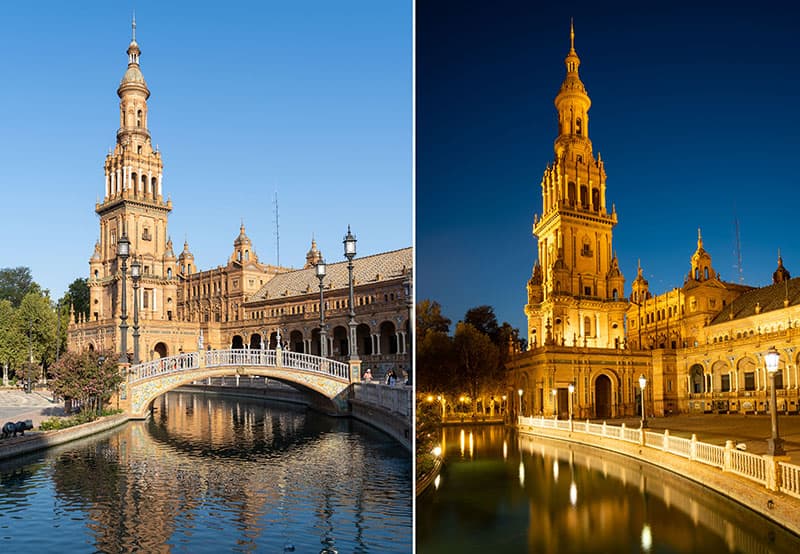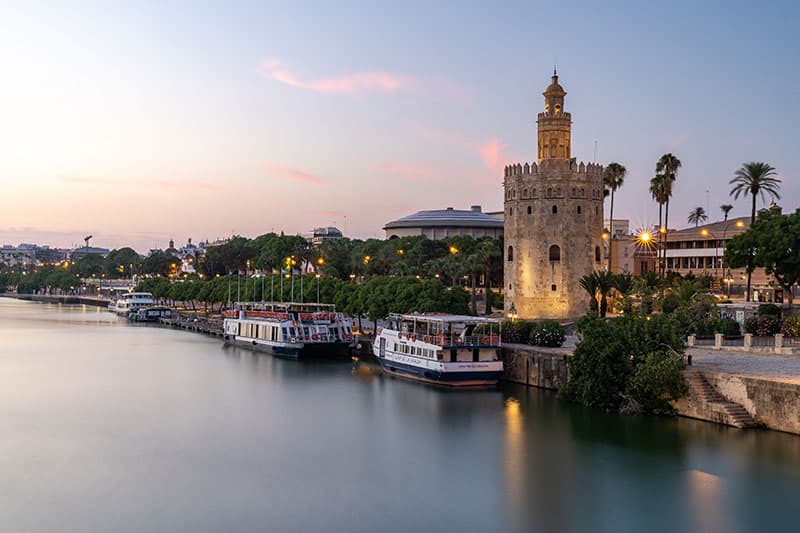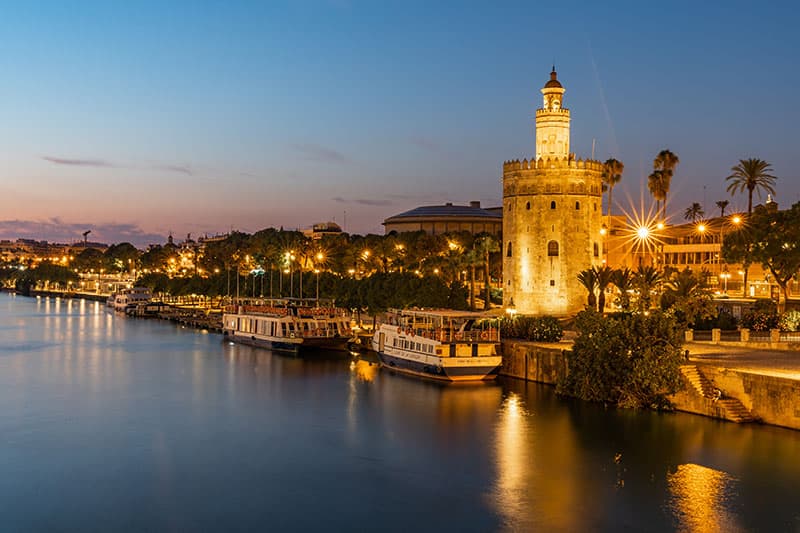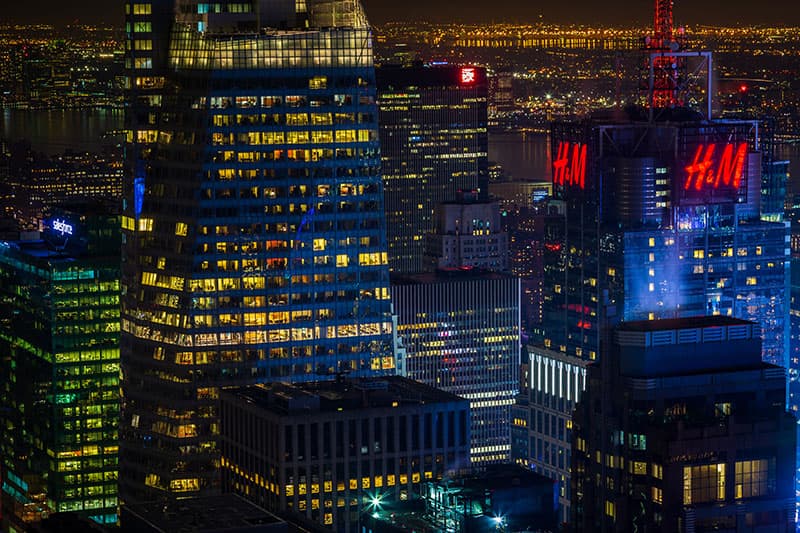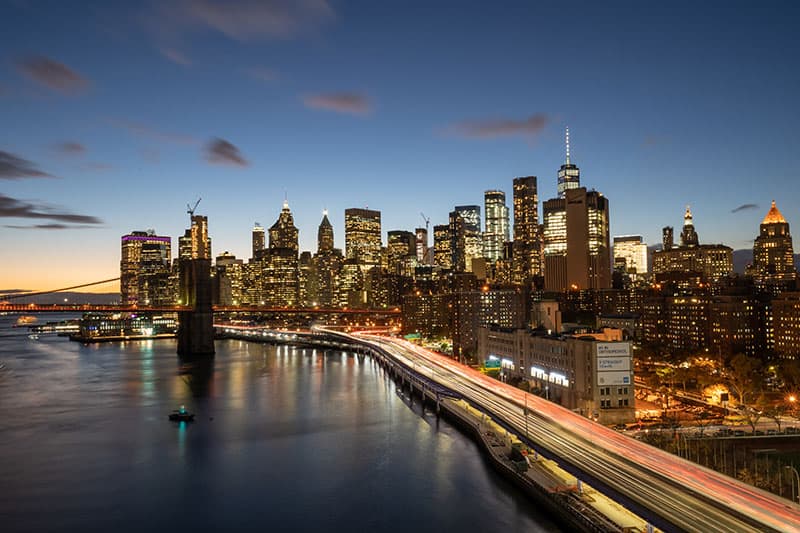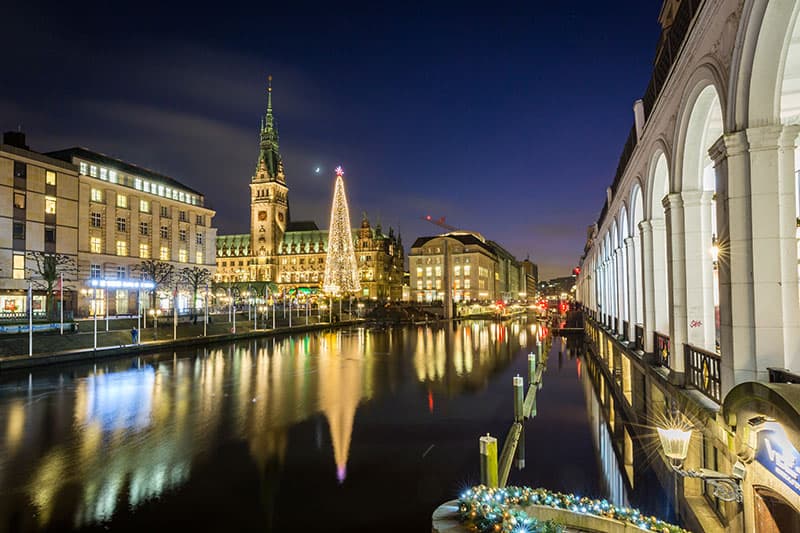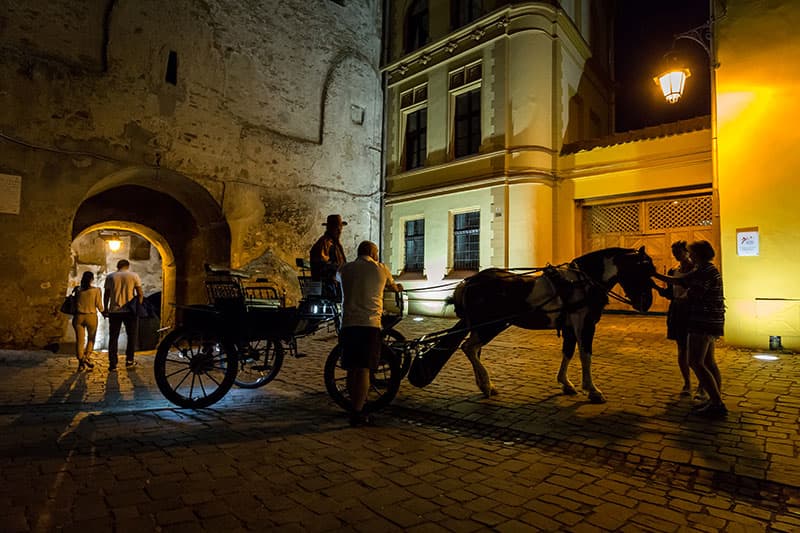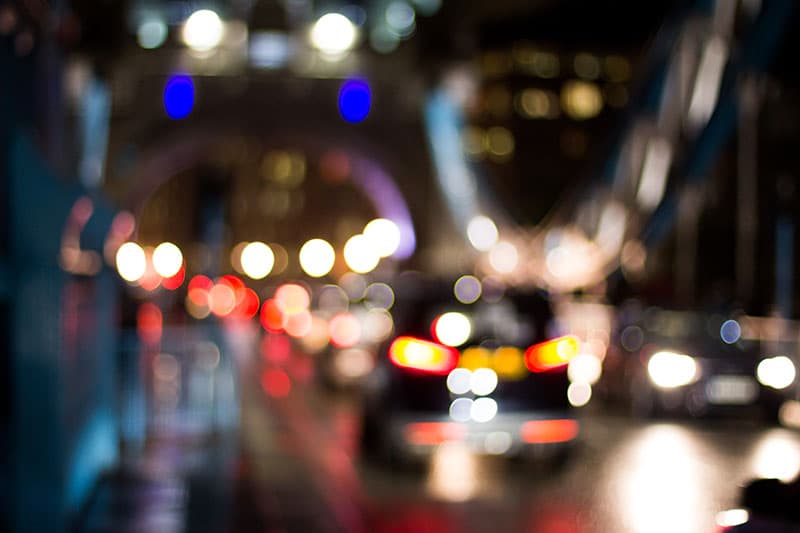While there are a number of factors that need to work in harmony to create a beautiful photograph, one of the most important is light. By applying even a basic understanding of light when photographing cities, you can transform the quality of your night shots.
Cities, even the iconic ones, can look uninspiring under flat light, whether caused by dull, grey clouds or harsh, bright sun. Yet, light can change everything, and thankfully in cities, we have the opportunity to work with both natural light as well as numerous artificial light sources to improve and enhance our images.

Combine natural light with artificial light sources to create stunning cityscapes. Sony A7 III, 24-70mm, 49sec at f/14, ISO 100. Credit: Matt Parry
Natural light for night shots
If you shoot any form of outdoor photography then it’s essential to understand the basic principles of natural light and how it affects the type of scenes you love to photograph. Cityscapes, much like landscapes, look great in the ‘golden hour’ periods of sunrise and sunset as the diffused, warmer light and the angle of the sun mean the sky will often enhance rather than diminish your scene. This is also the case for the ‘blue hour’: that period just before sunrise or after sunset. This is when the sun is sufficiently below the horizon and, as the name suggests, the sky takes on a blue hue which gets deeper, darker and richer the further the sun recedes, until blue becomes black.

Research and plan your blue-hour shots to make the most of the optimum light conditions. Canon EOS 5D Mark III, 16-35mm, 13sec at f/16, ISO 100. Credit: Matt Parry
Artificial light sources
If we focus on the evening blue hour, as the sun recedes below the horizon, this is the time when you will notice any artificial lighting. From car headlights to office windows and street lamps, the city starts to take on a different appearance as day turns into night.
In many cities, you will find that photogenic buildings and structures such as monuments, cathedrals or bridges are lit. This will often make them look far more spectacular and photogenic than in daylight. Similarly, in any city set around bodies of water such as rivers or harbours, you will find that the city lights offer a boost of colour to your images as the lights extend onto the water in hazy reflections.
Ultimately, for photographers, the added bonus of artificial light is that those who have an understanding of long-exposure techniques, and are armed with a bit of planning as well, can utilise both natural and artificial light in tandem to create striking images.
Planning
When exploring cities, especially ones you have never visited before, there is nothing more enjoyable than simply wandering around and taking it all in. While this approach is great for daytime shooting, it often pays to carefully plan your photography for the golden and blue hours – the key times for shooting cityscapes. These periods of optimum light are short-lived, and even just a couple of minutes can transform the same scene. By doing a recce of a specific location during the day you can work out the best angles for composition as well as determine access and any restrictions you might encounter.
If you are photographing city lights, you need to work quickly and efficiently to determine the best exposure, as the dynamic between artificial light and natural light is constantly changing. This means you have to manage your settings to get the correct exposure where the highlights are under control but there is enough definition and detail in the shadows to create your final image.
Getting the exposure as accurate as possible in-camera can mean less time in post-production, yet editing is often needed to adequately represent what the human eye sees. Some choose bracketed exposures to capture the scene and merge later in Lightroom or Photoshop, while others prefer single exposures that can be enhanced in post-processing. Both techniques are equally valid, and it depends on your preferred workflow and, to a certain extent, your camera’s capabilities.
The exposure triangle
The exposure triangle is a common photography-learning tool looking at the three key settings of your camera and how each affects how much light it takes in. Aperture, shutter speed and ISO can all be tweaked to create roughly the same exposure. However, the balance of these settings can affect the quality and look of the final image, so it is important that you understand and take control of them.
Turn the camera to manual mode and select the lowest standard ISO your camera has (normally ISO 100); this will give you the cleanest images. Next, set the aperture. Depending on the scenario and what effect you are trying to achieve, if you are shooting a cityscape and want to keep the scene in focus from front to back then try a narrow aperture setting between f/11 and f/16.
At these settings, your ISO and aperture are not letting much light into your camera so the final side of the triangle to adjust is the shutter speed. The shutter speed will be completely dependent on the amount of light in the scene, so initially, this is the variable to work with to get the shot you want.
Considerations for night shots
In low light, to compensate for the low ISO and narrow aperture, a longer shutter speed is typically needed. This means using a tripod to keep your camera perfectly still is essential. Any slight movement will of course affect the image and ruin it. Based on shooting a standard cityscape such as the one taken in Seville, Spain (see pictures above), as the light changes from sunset to the blue hour you will need to continually adjust your shutter speed to compensate for the diminishing natural light and the resulting stronger artificial light.
In this example, each image was shot approximately 10 minutes apart at the same ISO and aperture, with the shutter speed being the main variable. Filters were needed to hold back the light to get a similar effect in the water, but the changing light conditions are clear to see. Notice how the natural light and colour in the sky change as the sun sets, while the artificial light grows stronger which offers more contrast against the darkening sky.
As you get further into nautical twilight you may find you need to use shutter speeds greater than 30 seconds to get sufficient detail in the shadows. Simply switch to bulb mode or, if you prefer, increase your ISO slightly or widen your aperture to keep the exposure shorter
Conclusion
Cities take on a whole new appearance when bathed in the glow of artificial lights. Combined with the right ambient lighting conditions, they can look spectacular. Using long-exposure techniques will give you clean, sharp urban images; simply adjust your exposure to account for the changing light or shooting scenarios.
Matt’s top tips to improve your city-light shots
Mastering natural light using apps
Many outdoor photographers are accustomed to using apps such as the Photographer’s Ephemeris or Photo Pills to check sunrise and sunset times. But these apps also offer the times for astronomical, nautical and civil twilight. It is worth paying attention to these as they are important times for blue-hour photographers shooting city lights – the blue hour will typically fall between civil and nautical twilight. While it is possible to continue shooting during astronomical twilight and into nighttime, the sky can be very dark which contrasts with the bright highlights of the artificial lights and makes exposure difficult to manage.

Shooting through windows may show imperfections in the glass, yet offer good views of city lights. Canon EOS 5D Mark III, 16-35mm, 30sec at f/14, ISO 200. Credit: Matt Parry
Abstract cityscapes
As the sky gets darker experiment with focal lengths. Don’t feel the need to include the whole scene or the sky, as what you leave out is just as important as what you include. Use a telephoto lens or careful cropping in post-production to create amazing abstracts.
Shooting through glass
Have you ever found yourself in a hotel room with a spectacular view over a city yet the window doesn’t open more than a couple of inches? Some cities are blessed with superb vantage points from skyscrapers, hotels or church towers. But this often means shooting through thick glass, which can present a real challenge for long exposures during the blue hour or at night. Dirty or scratched glass, particularly on the exterior, will affect the final image and it can be extremely difficult to deal with in post-production. Another challenge is the reflections caused by interior lights that will ruin your images.
Don’t be put off though as there are ways to make sure your shot is a keeper. First, find the cleanest section of the window that gives you the composition you are after. Shoot as close and as straight onto the glass as possible (avoid the lens and glass touching). A circular polariser may help reduce some of the reflections, but this alone is often insufficient. If you can turn off any room lights then do so but recognising this is not always possible, you still need one last step. You will need to cover that light from hitting the window and thus appearing in your image.
There is a ready-made solution for this in the form of a lens skirt: a large, black lens hood, which also attaches to the window with suction cups to cut out reflections. A cheaper, but less practical, alternative is to cover your camera and lens fully with a matt, black top. Holding your top tight to the window and using a remote shutter release or delayed timer can prove effective – don’t let the top creep into your frame or knock the camera.
Include people

Credit: Matt Parry
Including people in city-scenes is sometimes unavoidable, yet it can give the scene both scale and context. Blending architecture with street photography can create stunning shots that are more dynamic or interesting than a people-free picture.
Beat the bad weather
Shooting long exposures in bad weather is undoubtedly a challenge, yet if you can keep your lens free of rain for the duration of your exposure then it is possible to get some really strong images, as gloomy skies or wet pavements can add drama to your scene.
Traffic trails
Light trails can be created by any light source moving through your image. Vehicle lights in particular are an ideal subject for blue-hour trails. Shooting in Bulb mode, open the shutter before the light source enters the frame and close it once it is fully out of shot after reaching the correct exposure.
Star-bursts

Credit: Matt Parry
A crisp, clean starburst can make a nice focal point in your image and can make street lamps and artificial light sources more interesting. A long exposure at a narrow aperture of around f/16 should give you a nice burst. Also the more aperture blades in your lens, the more pronounced and striking the look.
Reflections
Photographers can make use of a whole host of subjects to create beautiful reflections in their city scenes, such as rivers, canals, lakes, harbours or even puddles. Look for bodies of water that are calm and still to create cleaner reflections. It’s best to avoid shooting reflections in windy and rainy conditions.
High-ISO shooting
It is very possible to capture city lights without the use of a tripod – particularly useful if you want to capture people in the scene. You will need to boost your ISO, which will increase noise, but by focusing on the pockets of light you can keep the important highlights in check.
Bokeh
An interesting effect when shooting city lights is to throw the scene out of focus so that the lights take on a circular bokeh look. Simply compose your shot, make sure you are in manual focus, and then adjust the focus until you get the look you want.
Christmas markets
Christmas market season is fast approaching and this is a great time to get out into a city to shoot the lights. While the markets are often too busy for tripods, the lights and crowds lend themselves far better to high-ISO shooting at wider apertures.
Night shots kit list
- Tripod While many current cameras can deliver excellent shots in low light, to truly capture sharp, clean shots of city lights you need the stability and flexibility offered by a sturdy tripod. The best model is the one you can comfortably carry. For me, the MeFoto Roadtrip is a great, lightweight option.
- Mini tripod There are circumstances or locations where a full-sized tripod is either not allowed or not practical to use. As an alternative, a smaller, strong, tabletop tripod is perfect to place on top of walls. I picked up this excellent Leofoto MT-03 mini tripod at Photokina.
- Remote shutter release Many current cameras offer app connectivity, which allows you to control the settings and shutter through your phone. But I still prefer to use a remote release, particularly if shooting in Bulb mode. A basic third-party model can often be picked up cheaply.
- Lens choice Rather than spend your hard-earned money on a new camera, a lens upgrade is often a wiser investment. If you like a clean and sharp starburst effect or smooth, circular bokeh in your city lights then look for a lens with 9 or more aperture blades, such as the Canon EF 16-35mm f/4L IS USM.
- Filters If you are shooting city lights during sunset and the blue hour, then filters can be particularly useful. A circular polarizer is great when working with reflections, while ND and ND Grad filters allow you to manipulate natural light to get the shots you want.
Matt Parry is a travel photographer and writer; he has been featured in leading travel and photography publications. He has presented videos on travel photography as well as given talks and workshops for Wex Photo Video, the RPS and others. See mattparryphoto.com and @mattparryphotography
Read more about night shots:
- Night photography with distinction
- The night sky: How to photograph stars and the Milky Way
- Best camera filters for photographers
- Liam Wong shares new book of cinematic cities at night


